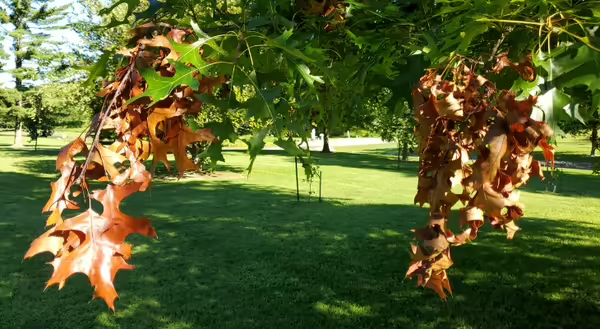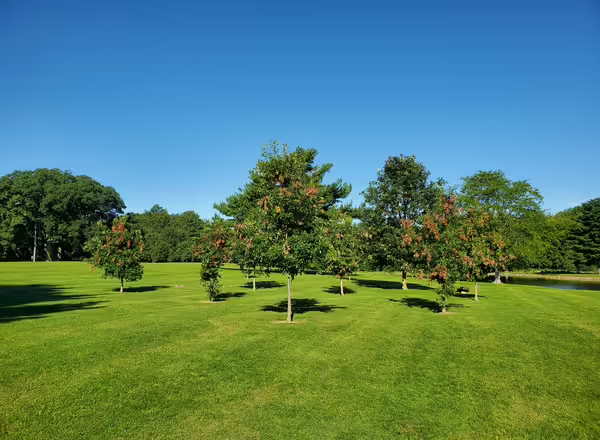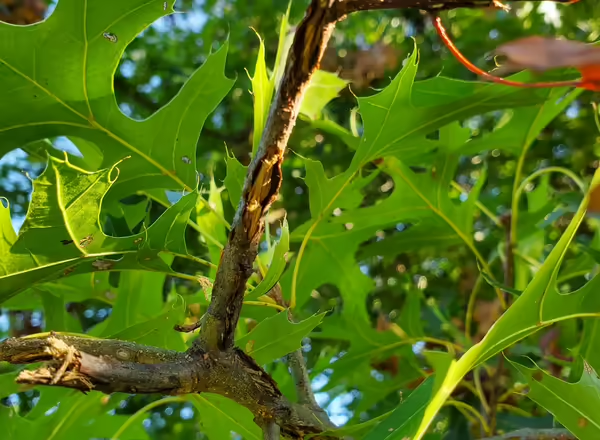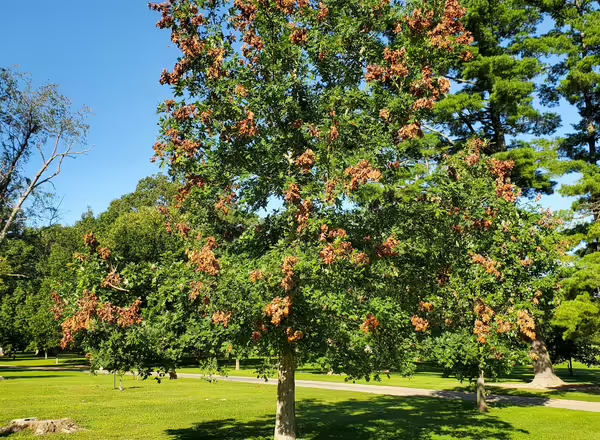
The signs of this year’s historic cicada hatch are still around, although all of our periodic cicadas are now quietly underground, feeding away on tree roots for the next 13 years. After piles of molted shells and dead adult cicadas earlier in the summer, we are now seeing their signature on woody plants used for egg laying, as their impact becomes more evident in the damaged branches and twigs.
These abundant insects emerged en masse across May and June, mated, and females began egg laying in nearby trees or shrubs. They targeted limbs ½” and less in diameter, laying eggs by making a shallow slit with their spike-like ovipositors. It's these minute slits that did all the damage to our trees and shrubs.


Today, damage can be identified by examining twigs for ovipositor slits. They tend to prefer the bottom side of twigs at the branch tips, which makes inspection easier. Although in areas of dense population, I’ve noticed slits on nearly all sides of twigs.
Often, cicada damage is easily identifiable by the dead, brown leaves still attached and waving in the wind. In many cases, twigs have snapped at laying sites and are either hanging straight down or have fallen to the ground. However, a lot of the damaged twigs that died have not broken off yet and remain attached in their original alignment.
In so many cases, I’ve found heavily impacted limbs that are still alive and seem to be doing fine, as evidenced by their healthy, green leaves. These trees appear to be mounting a response by growing over the wounds. You can often see new wood forming at the edge of the slits, which is an excellent sign that the twigs will survive.
I imagine that some twigs that have not shown signs of dead leaves yet may still die before leaf drop. Any hot weather this time of year adds stress to these trees and may ultimately be the tipping point between the tree mounting a growth response and the twigs dying back.


If you are seeing damage from cicada egg laying on your trees, it may not be that big of a deal. For larger, healthy trees, the damage should be no problem at all. It may be a bit unsightly as branch tips die, turn brown, and eventually fall off, but it should be of no consequence to a mature, healthy tree.
Newly planted trees and smaller-sized trees with extensive damage are of concern. Since most of the canopy of smaller trees consists of limbs ½ inch in diameter or smaller, heavy egg laying can impact a significant portion of the young canopy. I worry the most about trees that have had 1/3 or more of their overall canopy damaged or killed.
If you have smaller trees with heavy damage, be sure to nurse them along this year during any hot, dry weather. Simply watering them during dry times and adding a layer of mulch is about the best thing we can do.
In addition, be sure to limit any further disturbance to the tree canopy, such as bumping them with the mower or brushing by low limbs as you walk. Even minor bumps can snap off damaged twigs that may otherwise recover. Protect the root system by limiting soil disturbance underneath your tree. The majority of tree roots are very shallow, so any disturbance at all can be impactful.
For any cicada-damaged tree, it's helpful to prune off the broken or dead tips you can reach. This will allow the tree to more easily grow over the damage and will limit the introduction of insect pests or rot-causing fungi. Be sure to prune off dead twigs back to the nearest live branch union.

As a final caution, be sure that any dieback you see on trees or shrubs is, in fact, from cicadas. Diseases, such as bacterial leaf scorch and verticillium wilt, tend to present damage this time of year since trees get stressed by hot weather in July and August. Early fall color can also mimic cicada damage and is a sign of serious health issues.
Remember, cicada damage will be limited to branch tips, and leaves will be entirely dead and brown. Disease stress tends to be more widespread across the canopy and more evenly distributed, with leaves that are often only partially impacted and some green tissue still present.
While cicada damage may not be that big of a deal on large trees, bacterial leaf scorch or verticillium wilt are serious pathogens. Drought stress can be a sign of other health issues which may need to be looked into. So, it’s important to diagnose the root cause of tree damage this time of year to be sure that you are doing everything possible to preserve the health of mature trees. After all, they are likely the most valuable plants in the landscape and will certainly pay dividends if they remain healthy.